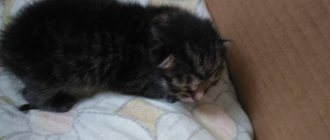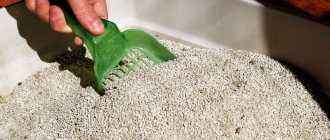Your cat spends a long time in the litter box without excreting anything other than a few drops of urine. Why can't my cat pee? What's wrong and will it get better on its own? They may have had cystitis in the past, but is it a recurrence? The cause may be a bladder blockage, and this is a real cat emergency.
Let me start by saying that if at this very minute you have a cat who is currently struggling or straining to pee and if he is showing any form of discomfort, pain or distress or in any way If you are not healthy, you should stop reading and contact your veterinarian immediately. If left untreated, bladder obstruction kills quickly and requires prompt treatment. Don't read to the end, call your veterinarian. Jokes aside.
Norms of urination in cats and cats
Fluid volume in animals usually varies from 50 to 200 milliliters per day. But this figure depends on several indicators. This includes:
- weight;
- age;
- floor;
- nutrition.
For example, a small kitten up to 2-3 months is unlikely to make large puddles. And an adult cat of 3-4 years old can get half of the tray dirty from one trip to the toilet.
What to do if the litter box is clean, but the cat is behaving too unusually
Newborn kittens can pee once a day, and up to 3 months old - up to 2-3 times a day. This is difficult to track if the animal is not litter box trained. Sometimes even babies at 4 months pee only once a day, this is also a normal case.
Attention! This should not happen in adult animals. If the cat cannot pee more than once a day, then you need to look for the reason.
Urination may differ only slightly between male and female cats. In cats, the urethra is thinner but longer. The outflow will be different - up to 5 times a day, regardless of whether he is neutered or not. Females will go to the tray up to 3 times a day, provided they have normal, nutritious food.
Variant of normal behavior of a cat
Reasons why a cat cannot pee or only walks a little
A representative of the cat family should not be allowed to go to the litter box less than twice a day. This is a situation that requires the intervention of the owner if it lasts longer than one day and the cat does not leave the house.
The cat cannot go to the toilet for the most part: what to do
It is important to understand that this is a dangerous situation that cannot be ignored. Insufficient bladder emptying can lead to serious problems.
Why can't a cat pee:
- urolithiasis disease;
- inflammatory processes in the urinary system;
- kidney diseases;
- cystitis;
- congenital pathologies;
- overexcitation in uncastrated animals;
- mechanical blockage/obstruction.
Attention! If you had to castrate or sterilize a cat, you need to monitor the food and diet. Poor quality feed and large amounts of dairy products can lead to the rapid development of urolithiasis.
Disturbing animal pose
Household reasons
If a cat cannot go to the toilet, then this may have a simple reason - overstimulation. In this case, secretion begins from the gonads, they increase in size and close the urinary ducts. Sometimes, due to overstimulation, a plug of discharge appears in the urethral canal.
A common occurrence is cystitis. In its standard course, the animal will simply urinate frequently. But sometimes the urethral canal can be so blocked by inflammation that the cat cannot pee at all. If the excretory tracts are too swollen, the throughput will be reduced to a minimum. It is necessary to treat this disease; complete blockage should not be allowed, this leads to serious complications and deterioration of well-being.
Even a simple household injury - an unsuccessful jump or fall - can lead to difficulty urinating. At night, cats like to lie down on the walkways - the owner could simply not notice the animal and step on it. If a cat cannot pee after an injury, this is a reason to urgently contact a veterinarian and provide first aid to the animal.
Unusual animal behavior
Kidney diseases
This cannot be determined at home; you need to contact a specialist. Only a veterinarian can detect the presence of a disease or developmental pathology. Among the indirect signs of the presence of the disease:
- nervous or noticeably passive state;
- elastic belly;
- the animal does not lie down on its stomach;
- blood in urine;
- the cat is lethargic, tired;
- elevated temperature;
- the animal walks past the tray.
Important! In this case, only a doctor can prescribe treatment. There is no need to try to treat a cat on your own, without visiting a doctor, if it has blood in its urine.
Urolithiasis disease
A disease that can only be diagnosed by a specialist. It is more likely to affect animals that have undergone sterilization or castration, as well as animals with a poor diet. If the cat eats cheap food with a large proportion of grains, or drinks a lot of milk, this can trigger the onset of the disease.
During the development of the disease, stones, salt or sand gradually form in the excretory canals. They affect the functioning of the bladder, and the cat will not be able to force itself to pee due to pain. In later stages, the passage may become clogged with foreign bodies. This leads to inflammation and rupture of internal organs due to the accumulation of urine there.
Particularly susceptible to the development of urolithiasis are overweight cats that are reluctant to move and lead a sedentary lifestyle.
The cat fits into the tray
Note! Without treatment, the cat will not be able to pee, this can lead to bleeding and death of the animal.
General symptoms
If the tray is open, owners quickly detect urine retention - the litter remains dry. When time is lost, the general condition worsens to the point of refusal of food, apathy, and coma. Symptoms vary depending on the cause of the condition.
Obstruction
There is urine, but something is preventing it from coming out. In addition to the presence of stones, obstruction is caused by neoplasms, injuries, parasites, and inflammation. Sometimes we are talking about congenital pathology. The cause of the obstruction may be a spasm caused by stress or illness.
Constantly running to the litter box, the cat cannot pee for a long time or urine leaks drop by drop. The pet tenses as if defecating, meows in pain, takes a long time to choose a position, and licks itself. There is an urge, but going to the litter box does not bring relief. Due to a full bladder, the abdomen becomes tight. If your cat pees blood, the urinary tract is most likely damaged.
Dysfunction
There is no or very little urine. The abdomen is not tight, but abdominal pain is possible - the posture is constrained, movements are cautious, weakness increases. The urge is of normal intensity or absent. The discharge is scanty, cloudy or absent. The cat's breath smells obsessively of ammonia or rotten fish.
If this is not an acute condition, at first everything is relatively fine. Owners think about how to make the cat pee - change the litter, drink it out. As it worsens, swelling of the paws and collar area develops. Possible pulmonary edema, tachycardia, cough. The body gets rid of toxins in other ways - vomiting, diarrhea.
How to tell if your pet has urinary problems
An attentive owner will definitely pay attention to any changes in the pet’s behavior. This could be frequent urination - the cat will start running to the litter box frequently, literally every 10 minutes. The problem may turn out to be more dangerous - the tray is clean, but the animal is clearly behaving unusually.
Constipation in a dog: cannot go to the toilet in a big way
Additional symptoms that your cat cannot urinate or is in pain to do so:
- meows or whines pitifully;
- constantly licks the genitals;
- the color or consistency of urine has changed;
- blood, flakes, pus, mucus appeared in the tray;
- the smell or color of urine has changed dramatically, becoming sharp and unpleasant;
- drinks a lot;
- doesn't want to eat;
- nervous, moves restlessly around the apartment;
- does not allow you to feel your stomach; when you try to do this, it hisses and scratches;
- bends the hind legs or stretches them out uncharacteristically;
- doesn't want to sit on his hands.
Most of these symptoms indicate that the cat is unable to go to the toilet. This is a reason to see a doctor.
The first thing that will change in the animal’s behavior is that it will begin to walk in circles around the tray, as if not daring to sit in it. Sometimes the owner thinks that this behavior is related to the search for a partner, but this is a mistake.
A plaintive, painful meow will indicate that even rare urination does not bring him relief.
Attention! Puddles may appear in unspecified places - on sofas, carpets, pillows. Do not rush to scold a cat if nothing has changed in its life. She probably can't control the process.
How to tell if your pet is in pain
Self-diagnosis
The cat often goes to the toilet a little at a time
Only a doctor can diagnose a cat. But you can check for simple symptoms. Among them:
- bloating, abdominal cavity is hard and elastic;
- when trying to touch the belly, the cat will behave nervously or aggressively;
- the cat spins around in the tray, looks for a place, takes a long time to choose a position, but in the end the tray is dry;
- the animal does not sleep on its stomach or cannot sleep at all.
The presence of any of the symptoms should be a reason to visit the veterinarian. You should not try to help him with folk remedies or medications without confidence in the diagnosis, this can lead to disastrous consequences.
Causes
For those of you still here, let me elaborate. First of all, there are several factors that can cause a cat to stop urinating. This includes:
- “simple” cystitis, lower urinary tract disease in cats, idiopathic cystitis - different names for the same condition
- bladder stones
- bladder infection
- bladder tumor
- nerve damage
- damaged pelvis, tail or spine
- urethral obstruction or blocked bladder
Cystitis in cats is the most common cause.
© shutterstock
First aid
In a situation where a cat cannot pee, what should you do at home? First, it’s worth checking whether anything has changed in the cat’s life:
- castration;
- moving;
- change of owners;
- change of feed;
- low activity after illness;
- drug treatment;
- other surgical interventions.
If none of this has happened in the cat’s life, and the behavior is very different from usual, it is important to help him.
First aid
First aid:
- Place a warm heating pad or compress on your stomach and perineal area. Make sure that the cloth or heating pad is not too hot. It is necessary to warm, but not burn the abdominal cavity;
- place the animal in a bath or basin at a comfortable temperature. It is necessary to ensure that the water does not reach the heart area;
- control the volume drunk. The animal must drink a lot. If it refuses, it is allowed to pour in a little from a pipette.
A good way to help him cope with his illness is to play with him if he is active. But you shouldn’t force your cat to do this, especially if it’s hard for him.
Treatment methods at home
The treatment regimen is usually prescribed by a doctor after taking tests and identifying a diagnosis. Sometimes urgent surgery is required, in other cases it is enough to persuade the cat to drink so that he can pee.
Depending on the identified disease, different medications may be prescribed:
- diuretics;
- antiviral;
- anti-inflammatory;
- painkillers;
- hormonal;
- antihistamines;
- antibacterial.
The cat owner is required to buy everything according to the list written by the doctor and give according to the weight and sex of the animal according to the prescribed scheme. It is not advisable to change medications at your own discretion, cancel treatment at the first signs of recovery, or explain the cancellation of treatment due to the cat’s reluctance.
The animal must be comfortable using the tray
In addition, it is important to monitor the animal’s condition even after treatment. Among them:
- weight control – fat cats risk having problems with many internal organs due to obesity;
- control of drinking - the cat must drink a lot to stay healthy, especially on dry food;
- regular examination by a veterinarian - a specialist can identify many diseases in the early stages, when treatment is minimal;
- control of room temperature - it is important for castrated and sterilized animals not to lie on cold surfaces so as not to cause cystitis;
- completely abandon salty foods in the animal’s diet - remove smoked meats, salty foods, and food with a high salt content.
Preventive measures
It is quite difficult to cure the reason why a cat cannot urinate; out of 10 cases there will be 9 obligatory relapses. To alleviate your pet’s condition, preventive measures are important:
- Avoid overcooling your cat. The pet should not lie in a damp place, on concrete; if he wants to soak up the sun, it is better to do this on a warm blanket.
- Timely vaccination will lead to fewer diseases, which means fewer microorganisms will enter the cat’s body.
- A well-designed diet for an animal helps to avoid recurrences of inflammatory conditions in the animal’s genitourinary function. It is necessary to completely exclude all prohibited foods. Even once using a prohibited product can cause a relapse.
- Drinking plenty of fluids helps flush out your pet's bladder. Moreover, the water must be fresh and clean, and always be freely available to the animal.
- There is a special dry food available for sale for cats with disorders of the genitourinary system.
Unfortunately, it is impossible to completely cure urolithiasis in a cat. A caring owner should surround the pet with attention, regular preventive examinations, constant use of medications and a balanced diet. Such measures will help the cat lead a normal life.
What will the veterinarian do?
The first thing the doctor will do is insert a catheter to alleviate the animal’s health condition and remove fluid. Only a professional is allowed to install it - at home, trying to install a catheter can result in serious injury to the cat and scratched hands of the owner.
Then the cat’s bladder is washed with antiseptics. This is a rather painful procedure, so it is performed under general anesthesia. Once both procedures are completed, the specialist will perform a series of tests to determine the cause of urinary retention.
It is important to take tests and, if necessary, conduct additional ultrasound and other recommended procedures. You cannot treat an animal at random without making a correct diagnosis.
What tests can be taken:
- blood biochemistry and hormone levels;
- general urinalysis, acid-base balance, acetone level;
- Ultrasound;
- X-ray;
- a study aimed at comparing fluid intake and excretion.
Attention ! The catheter is sewn in only for a few days. If the specialist said to keep the catheter for 4 days, then after this period you need to come in to remove the device. In addition, frequent or prolonged insertion of a catheter can negatively affect health and cause swelling and swelling of the urinary tract.
Catheterization of a cat, putting on a collar
While the catheter is being sewn, you need to keep the animal in a special collar so that it does not injure itself trying to get out the interfering foreign body.
How to help a cat if he can’t go to the toilet?
Never massage your cat's belly when this disease occurs, as this will only make the situation worse. In the clinic, first aid involves installing a catheter to drain fluid from the body. This procedure is very painful and can only be performed by a qualified doctor. Sometimes such an operation is performed under general anesthesia.
During catheterization, antiseptics are used to flush the bladder. It is prohibited to carry out this procedure too often, as it also leads to swelling of the urinary tract. The doctor will find out the cause of difficulty urinating and prescribe appropriate treatment.
Usually cats are given painkillers and herbal infusions. Rose hips, lavender, plantain, horsetail and lingonberries help well with such problems. Sometimes a hot bath helps : the pet is immersed in water up to the heart area for 10 minutes. They also prescribe, if it is impossible to go and pee, boiled pumpkin and a dessert spoon of strawberry juice.
Anti-inflammatory drugs are prescribed for all kinds of inflammation. Even after the results appear, you must continue to take them. must be included in your pet’s diet , and in the spring you can give him nettle . In addition, the cat is prescribed active games and frequent walks. Most diseases of the urinary system are chronic, so it is advisable to take herbs for a long time and repeat the course of treatment constantly.
Kidney collection perfectly helps to remove sand from the body. It is sold in any pharmacy, but it is better to consult a specialist. You can constantly give your cat a decoction of black currants, parsley, birch leaves and bearberry. You should treat this way for at least a month.
Diet for difficulty urinating
It doesn't matter what diagnosis the cat was given. If she has difficulty going to the toilet, this is a reason to reconsider her diet. It is necessary to exclude cheap “economy” brands of food from her diet. They often irritate the mucous membranes, kidneys and urinary tract, causing additional pain in the cat’s body.
These foods contain a lot of salt, preservatives and dyes. The meat content there will be in last place, if it was used at all in the production of feed. It is recommended to switch the animal to expensive food of special brands designed specifically for animals with urological diseases.
It is strictly forbidden to give your cat:
- pork;
- salt;
- milk;
- raw meat;
- raw fish.
Some foods, such as pork or milk, will make the urine thicker, making it more difficult for you to pass out. Protein foods will overload the kidneys, and raw fish will create the likelihood of kidney stones.
The diet must be agreed with your doctor
How to make a cat pee: basic methods
Biological material can be collected in different ways. When selecting the optimal method, the age of the cat, its habit of using a tray or bath, the type of litter used, as well as the suspected disease are taken into account. When issuing a referral for analysis, the veterinarian gives advice to the owner on how to collect urine. The accuracy of the results depends on the correct execution of the procedure.
It is important to follow a few simple rules:
- Morning urine obtained immediately after a pet’s night’s sleep is considered ideal for analysis. However, if necessary, it is permissible to collect material at any time of the day.
- Urine cannot be stored for a long time. The most reliable result will be if you send it to the laboratory no later than 1-2 hours after collection.
- The optimal volume for analysis is 10-20 ml. However, if the cat produces little urine, the test can be done by examining 5 ml of liquid.
Urine must be collected in a sterile plastic container. You can purchase it at a pharmacy (regular or veterinarian), pet store, or in the “pet supplies” section found in some supermarkets. In the absence of a special container, you can take a jar of baby food. First, it should be thoroughly washed with baby soap and treated with steam.
How to collect urine if your cat is used to using the litter box
If your pet prefers to go potty, collecting urine will also be easy.
The algorithm is as follows:
- Wash the cat litter thoroughly with soap or baking soda solution and rinse with boiling water.
- Wait until the animal has emptied.
- Carefully pour the urine into a container (necessarily sterile).
- Close tightly.
- Deliver to the veterinary laboratory.
There are several ways to collect urine from a cat that is used to potty litter. The simplest of them is to try to take a clean (new) tray. If your cat refuses to urinate in it, you can buy granules that cannot absorb moisture. This special filler does not react with urine, so it will not distort the results of the study. You can buy it at any pet store.
After emptying, you need to tilt the tray, slowly and carefully drain the liquid, or collect it with a pipette into a prepared container.
Danger of difficulty urinating
If treatment is not started in time, the animal will begin to lose weight and activity, hair will grow, and the disease will have time to become chronic. These include pain every time you try to pee, restless or exhausted behavior. Retention of urine in the body can cause intoxication of the cat and serious consequences for its body.
Some diseases, such as urolithiasis, can cause complete blockage of the urinary tract. This will provoke inflammation and rupture of internal organs, resulting in the death of the pet.
It is advisable to conduct regular examinations with a veterinarian and monitor the condition of the cat. Any disease, even not too serious, can become purulent, chronic or life-threatening for your pet. To avoid this, it is important to monitor the animal, and at the first sign of strange behavior, it is better to immediately contact a specialist.









